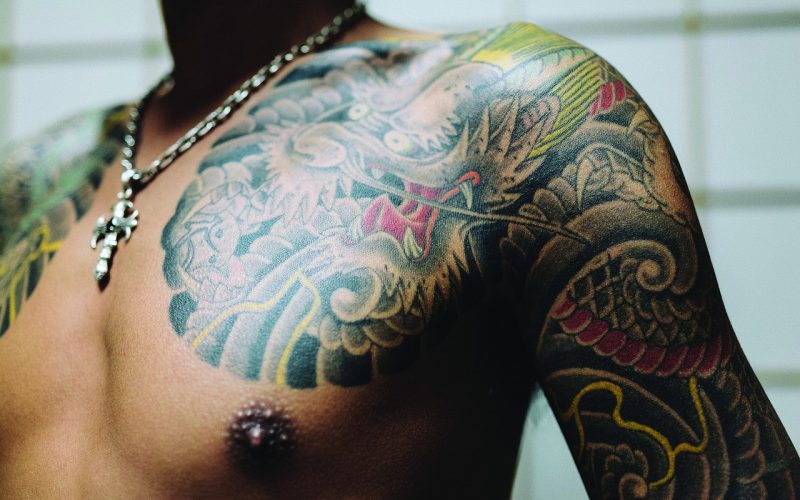‘Irezumi’ is a term used to describe traditional Japanese tattoos. Actuality, the word ‘irezumi’ means ‘tattooing’ in Japanese, or, more precisely, the insertion of ink beneath the skin to produce a permanent imprint.
Said Irezumi refers to all types of tattooing rather than a single Japanese style. Other terms for tattooing in Japan include ‘horimono’, which means ‘engraved objects,’ and ‘tebori,’ which means ‘hand-engraved.’
Tebori is also a term used to describe Western tattoos. Waborii is a traditional Japanese tattoo, with the ‘wa’ standing for Japanese.
While an ‘Irezumi tattoo’ denotes a conventional tattoo to the rest of us, it would translate to a ‘tattoo tattoo’ in Japan, as with many borrowed terms – a typical characteristic of language and cultural differences!
Below are the different types of traditional Japanese tattoos.
1. Hou-ou Tattoos – Japanese Phoenix Tattoos
This is one of the different types of traditional Japanese tattoos, And the Phoenix is an emblem of the imperial household in Japan.
As a result, the symbolism of Japanese phoenix tattoos is frequently centered on imperial traits such as obedience, justice, fire, and sun.
On the other hand, the Phoenix may represent harmony and discord, as well as good and terrible times.
The Phoenix is frequently represented in huge tattoos, with a larger neck, enormous wings, and a color scheme that includes fire and sun.
2. HebiIrezumi Tattoos – Japanese Snake Tattoos
In Japanese, Hebi means snake, while Irezumi signifies tattooing. Snake tattoos in Japan frequently depict the oriental concept of a snake.
Nonetheless, the snake is associated with rebirth, metamorphosis, and change in Japanese culture, owing to snakes’ proclivity for shedding their skin.
If a snake is white, it can also be a symbol of good fortune in Japan. However, if the tattoo represents a black or dead snake, it is considered a negative omen.
Snake tattoos are commonly found on the shoulder, arm, and chest, as these regions appear to display the picture best.
3. Foo Dog or Karajishi Tattoos – Japanese Lion Tattoos
The Japanese lion tattoo isn’t what you’d think it would be. The lion in these tattoos is a cross between a dog and a lion, with the lion’s ears pointed.
As a result, the symbolism of a tattoo like this is frequently dual, combining the meanings of the dog and the lion.
The symbolism frequently alludes to bravery, protection, strength, and devotion, among other things.
In Japanese culture, the dog and the lion represent heroic ideals and the urge to serve as guardians.
Japanese lion tattoos can be small or large, and they look great on the shoulder and arm, particularly the forearm calf, and thigh.
4. Ryu Tattoo – Japanese Dragon Tattoo
This is one of the different types of traditional Japanese tattoos. The Japanese dragon symbolizes strength, wisdom, blessing, and the power of good.
The symbolism comes from the notion that dragons can manipulate elements for the betterment of people and the planet.
The head of a camel, the body of a snake or fish, the talons of an eagle, and so on are common features of Japanese dragon tattoos.
It generally consists of components from various animals or mythological creatures and occupies a considerable portion of the body (most commonly the arm’s sleeve, shoulder area, upper and lower back, and upper thighs).
5. Kappa Tattoo – Japanese Turtle Tattoo
Another one of the different types of traditional Japanese tattoos is based on the legend of a gigantic turtle and huge salamanders emerging from the shallow water to snare anybody who comes too close.
Kappa’s are stereotyped as troublemakers and lawbreakers due to this misconception.
They allegedly enjoy kidnapping infants and assaulting women, which is far from legendary and only a cover narrative for law-breaking misfits.
We’re not sure why such tattoos are popular among foreigners, but it is suspected that most individuals are unaware of the Turtle tattoos’ history and meaning.
The most noticeable aspect of the tattoo’s design is the little water-filled chamber on top of the turtle’s head.
When the cavity is dry, the turtle is rendered helpless.
6. Tengu Tattoos – Japanese Supernatural/Ghost Tattoos
Tattoos featuring humanoid versions of otherworldly creatures with demonic characteristics are common.
The monsters’ noses are frequently extended, giving them a menacing look. They are frequently painted in red and black to highlight their wrathful meaning.
Since these creatures are typically associated with battle and devastation, the red hue represents militant iconography.
The tattoo is frequently put anywhere visible, although the majority of individuals choose the back, upper thigh, or chest.
7. Koi Tattoos – Japanese Koi Fish Tattoos
One of the most renowned Japanese and Chinese stories is that of the koi fish swimming upstream, reaching the top of a waterfall, and being turned into a dragon.
The koi fish is one of the traditional Japanese tattoos that symbolizes prosperity, success, perseverance, courage, and resolve.
Depending on the color, the koi fish tattoo may have various connotations, such as masculinity, motherhood, strength, courage, independence, success, money, desire, and so on.
8. Japanese Script Tattoos
A kanji tattoo is another traditional Japanese tattoo. Kanji are Japanese characters derived from Chinese characters.
Japanese script tattoos, such as brush strokes and graffiti tattoos, are highly popular in new school tattoos.
Since most people do not have the correct character tattooed, they generate a large percentage of regret tattoos.
Kanji characters can have many meanings depending on their context and application, and they are generally so complex that only a native speaker would understand them.
A spelling mistake is always a possibility while getting a script tattoo, but with Kanji, you’re taking a far bigger chance!
So, if you’re thinking about getting a Japanese tattoo with Kanji (or any Japanese tattoo with letters! ), make sure you run it by someone who knows the language before permanently inking it on your body.
9. Japanese Mask Tattoos
The ‘oni,’ or devil mask, was worn by Samurai and has now entered tattoo culture. Male demons known as oni punish evildoers and spread illness.
Some Oni are viewed as guardians of the innocent and virtuous, even though they are typically evil.
Samurai wore oni masks for two reasons: the first was to conceal their identity, but the second, and more essential, was to intimidate their opponents.
The Hannya mask is another mask that has become popular as a tattoo. It symbolizes a lady so full of anger and envy that she transforms into a monster, distorting her visage.
The Hannya mask is still used in Shinto rituals and Japanese theater today. Even with other types of tattooing, it has become a popular design.
10. Japanese Warrior Tattoos
Tattoos of Samurai and warriors from Japan are very popular. After all, everyone may be inspired by the concept of a warrior committed to their code of honor!
While a sleeve is a big commitment, it’s one of the finest ways to have a Japanese warrior tattoo!
11. Japanese Skull and Flower Tattoo
Tattoos are required in Japanese culture to demonstrate self-discipline, dignity, and commitment.
Every man should have a tattoo on his entire body to seem stylish and attractive. It is more appealing to females and teens.
The amazing thing about Japanese tattoos is that they can keep their unique style and that people still respect the original traditional style.
Depending on the season, Japanese tattoo designs for guys are available in various styles and designs.
12. Japanese Tribal Tattoo Sleeves
Tribal art is a popular abstract art style. They’re usually pure black, although they’ve gone a long way. Japanese tribal tattoos employ bright colors and effects not previously seen or used in black tattoos.
Many fascinating tribal designs are available in plain black or with other components incorporated.
People enjoy tribal dragons, suns, and animals; therefore, Japanese tribal tattoos appear in various topics.
Japanese tattoos have become increasingly fashionable in recent years. By reflecting Japanese culture and tradition as a whole, those tattoos have gone a long way.








